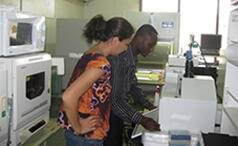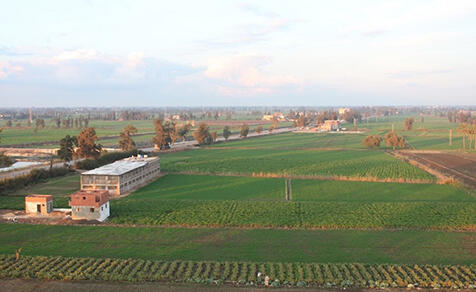Saving humanity from leptospirosis- Battling infectious disease with vaccines and diagnostic technology -
Saving humanity from leptospirosis
- Battling infectious disease with vaccines and diagnostic technology -
Research Fields and Areas
Infectious Diseases Control

Leptospirosis is a bacterial disease that is found throughout the world, mainly in tropical and subtropical regions. Contracting leptospirosis causes illness, such as jaundice, pulmonary hemorrhage, and kidney failure. In most severe cases it can lead to death. Japan is not spared from this disease, since many infections have occurred in southern Kyushu.
Despite the seriousness of this disease, there is little known about the true nature of the malady. To address this situation, this project conducted research with the aim of establishing preventive measures and developing a rapid diagnostic method including a detailed study in the Philippines, where the disease is widespread. The project successfully achieved many outcomes that will hopefully contribute in controlling leptospirosis.

Principal investigator (Japan):Professor YOSHIDA Shin-ichi
Faculty of Medical Sciences, Kyushu University
After graduating from the School of Medicine at Kyushu University, he studied immunology and bacteriology at Kyushu University's Graduate School of Medical Sciences. He then served as instructor, associate professor, and professor of microbiology at the University of Occupational and Environmental Health, Japan. Starting 1998, he served as professor in the Faculty of Medical Sciences, Kyushu University. His research covers pathogenic factors and the biology of pathogenic bacteria, such as Leptospira, Legionella, O157, Streptococcus, and Vibrio.
 Japan perspective
Japan perspective
Conquering disease is the shared aim of humanity, and to take part in that endeavor was a powerful motivation. By collaborating with researchers in the Philippines, this SATREPS project took up the challenge of conquering leptospirosis by a) determining the incidence of leptospirosis, b) developing a fast diagnostic method, c) working towards production of a vaccine, d) raising awareness and e) explicating the pathology of the disease. It was highly satisfying to have been able to meet most of these goals.

Principal investigator (The Philippines):Professor Nina G. Gloriani
Department of Medical Microbiology, College of Public Health, University of the Philippines Manila
She obtained her Ph.D. in Microbial Immunology and Immunochemistry from the University of Melbourne in Australia. She served as Dean of the College of Public Health, University of the Philippines Manila from 2007 to 2013, which included the period of the SATREPS project.
 Philippin's perspective
Philippin's perspective
Overall, I would like to believe that we accomplished much over the last 5 years. The capacity building component of the LepCon program in terms of infrastructure and human resource development were the best things that happened. We have a state of the art leptospirosis diagnostics facility that we could use for other pathogens as well, and our faculty and staff, including students were trained and learned many new advanced techniques both in Japan and in this renovated laboratory in the college. More students, both graduate and undergrads, are now able to use the laboratory facilities for their special studies, research projects, thesis and dissertation. We have generated several publications, disseminated our research findings in different fora, and the level of knowledge about leptospirosis in the Philippines has been enhanced considerably because of these. Technical cooperation with the Japanese scientists was excellent and the interaction fostered good professional and personal relations which contributed a lot to the successful outcome of the LepCon program technical cooperation.
Project outcomes
Determined the incidence of leptospirosis
Leptospirosis is a zoonotic disease, which means that it can be passed from animals to humans. Project researchers studied the state of infection of animals in the Philippines that humans have a high chance of coming into contact with. The results showed a high incidence of Leptospira antibodies* in rats (92%), carabao (water buffalo, 82%), dogs (83%), and pigs (67%) in urban areas like Manila, making it clear that people are constantly exposed to the danger of Leptospiral infection.
The fact that an animal has Leptospira antibodies means that, at the very least, the animal has been infected with Leptospira bacteria in the past, and indicates that there is a possibility that it still carries the bacteria in its body.
Enabled early diagnosis
Leptospirosis begins with symptoms such as a fever and headache, just like the symptoms of an ordinary cold. That similarity means that in a large number of cases the disease goes unnoticed until it has become severe. For this reason, project researchers developed a practical method for achieving a definitive diagnosis of leptospirosis at an early stage. This is potentially life-saving, because antimicrobial agents can be used to treat the disease if an early diagnosis is obtained.
Confirmed effectiveness of a vaccine
The most important countermeasure against infectious disease is prevention of infection, and inoculation using a vaccine is cited as an effective means of preventing leptospirosis. Therefore, project researchers developed an inactivated vaccine-a vaccine created based on bacteria that has had its infectiousness and toxicity eliminated through the use of chemicals. The effectiveness of the leptospirosis vaccine was confirmed using hamsters, making it possible to inoculate livestock and pets. This success can potentially avert damage to industry due to infection of livestock and contain infection from pets to humans.
Production of a diagnostic kit is expected to make it simple to perform a definitive diagnosis of leptospirosis. A prototype has already been made, and is currently being investigated in preparation for commercialization. Development of an effective vaccine for humans is also anticipated.



 Prof.YOSHIDA
Prof.YOSHIDA
There are two kinds of Leptospira -pathogenic Leptospira, which causes illness (infectious disease) in humans and animals, and non-pathogenic Leptospira, which does not. Non-pathogenic Leptospira dwells in soil and in fresh water, such as waterways, puddles, and rivers. Pathogenic Leptospira, on the other hand, usually inhabits the kidneys of animals without causing illness to the host (i.e., rats). When excreted in the urine, it survives in soil and water. There, humans and livestock that are susceptible to it come into contact with the bacteria, and are infected through the skin or mucous membrane. The infection then causes various states of illness ranging from mild, with symptoms such as fever and muscle ache, to severe, including jaundice, kidney failure, and pulmonary hemorrhage.

 Prof.YOSHIDA
Prof.YOSHIDA
Leptospira infects many animals, including pets and livestock. Mice and some other animals do not develop the disease, but become carriers, with the bacteria dwelling in their kidneys. Many pets are imported into Japan today, and they may be possibly infected with Leptospira. Imported flying squirrels have been confirmed as a source of infection, with recent cases of people being infected by them.

 Prof.YOSHIDA
Prof.YOSHIDA
 Leptospira dwells in soil and water, but because it shares its habitat with many other germs and molds, attempts at cultivating Leptospira usually result in a proliferation of other microorganisms that impedes the growth of Leptospira. What was needed was a culture medium that allows Leptospira to propagate while suppressing competing growth. We tested a variety of antimicrobial and antifungal agents, and after much trial and error, we developed a combination that was a good match with this objective. We named it STAFF, after the initials of the antimicrobial agents. When we sampled water from a puddle near a swimming pool and cultured it using STAFF, one of the Leptospira that emerged from the culture seemed more rugged and harder than others. Suspecting it was something that had not been seen before, we conducted tests, and were able to report discovery of a new species. We named it L. idonii, inspired by Professors Ryukichi Inada and Yutaka Ido of Kyushu University, who were the first in the world to discover that Weil's disease was an infection of Leptospira. Professor Inada already had a bacteria named after him, so we named this new strain after Professor Ido.
Leptospira dwells in soil and water, but because it shares its habitat with many other germs and molds, attempts at cultivating Leptospira usually result in a proliferation of other microorganisms that impedes the growth of Leptospira. What was needed was a culture medium that allows Leptospira to propagate while suppressing competing growth. We tested a variety of antimicrobial and antifungal agents, and after much trial and error, we developed a combination that was a good match with this objective. We named it STAFF, after the initials of the antimicrobial agents. When we sampled water from a puddle near a swimming pool and cultured it using STAFF, one of the Leptospira that emerged from the culture seemed more rugged and harder than others. Suspecting it was something that had not been seen before, we conducted tests, and were able to report discovery of a new species. We named it L. idonii, inspired by Professors Ryukichi Inada and Yutaka Ido of Kyushu University, who were the first in the world to discover that Weil's disease was an infection of Leptospira. Professor Inada already had a bacteria named after him, so we named this new strain after Professor Ido.

 Prof.YOSHIDA
Prof.YOSHIDA
 As part of this project, a laboratory, hamster facility, and an animal testing laboratory were installed for Leptospira research at the College of Public Health, University of the Philippines Manila. The people involved in the construction were tremendously helpful, and we are particularly indebted to the coordinators and Professor Emeritus Yasutake Yanagihara who exerted great effort to make sure that the devices and equipment delivered to the lab were the models we wanted. The process of exporting hamsters was also complicated, and we had to put in a good deal of thought to ensure that the MTA (Material Transfer Agreement) and other contract-related procedures would go smoothly. The research itself was not a problem, because we are used to the difficulties of conducting research.
As part of this project, a laboratory, hamster facility, and an animal testing laboratory were installed for Leptospira research at the College of Public Health, University of the Philippines Manila. The people involved in the construction were tremendously helpful, and we are particularly indebted to the coordinators and Professor Emeritus Yasutake Yanagihara who exerted great effort to make sure that the devices and equipment delivered to the lab were the models we wanted. The process of exporting hamsters was also complicated, and we had to put in a good deal of thought to ensure that the MTA (Material Transfer Agreement) and other contract-related procedures would go smoothly. The research itself was not a problem, because we are used to the difficulties of conducting research.

 Prof.YOSHIDA
Prof.YOSHIDA
Generally speaking, there are two types of diagnosis of infectious diseases-clinical diagnosis and laboratory diagnosis. Clinical diagnosis of Leptospira is difficult, so a laboratory diagnosis must be conducted in order to be certain. In order to determine if a patient has an infection, one approach is to look for pathogen-derived proteins and genes in the body of the subject suspected of being infected. Alternatively, you can study the antibodies and immune response to the pathogenic agent of the subject when our project started, testing was generally only possible at properly equipped laboratories, but that made it impossible to test outpatients, or to test at the patient's bedside or in the field. To overcome that limitation we attempted to develop simple and rapid diagnostic kits that could be used in such situations and produce quick results. Development of the antigen detection kit came to a standstill at the mass production stage, but mass production of the antibody detection kit is feasible.

 Prof.YOSHIDA
Prof.YOSHIDA
A vaccine that is effective on humans already exists, and is used in Japan to inoculate farm workers and other high-risk people. It has helped to lower the number of Leptospiral infection in Japan. This SATREPS project identified serotypes endemic to the Philippines, made a vaccine from them, and confirmed its effectiveness on hamsters. The vaccine's effectiveness in livestock still needs to be confirmed before beginning human inoculations. The researchers in the Philippines will handle that process, and we are confident that they will do a good job.

Infectious Diseases Control
 Republic of the Philippines
Republic of the Philippines
Case Studies
Contact Us
Japan Science and Technology Agency (JST)
Department of International Affairs
SATREPS Group
TEL : +81-3-5214-8085
Related articles
-
Infectious Diseases Control

 Republic of Ghana
Republic of Ghana
Developing new medicines for infectious diseases
- Studies based on Ghanaian medicinal plants - -
Bioresources

 The Republic of the Sudan
The Republic of the Sudan
Striking Out against Striga called Witchweed!
‐ Creating an Africa that can win the battle against root parasitic weeds ‐ -
Environment / Energy
(Global-scale environmental issues)
 Arab Republic of Egypt
Arab Republic of Egypt
Water conservation in the Nile basin
- Saving water provides resources to turn desert into farmland - -
Environment / Energy
(Carbon Neutrality)
 Malaysia
Malaysia
For a future in which people can live with peace of mind
- Developing scenarios for creating low-carbon societies -
















